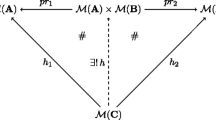Abstract
This article begins with a review of the framework of fuzzy probability theory. The basic structure is given by the σ-effect algebra of effects (fuzzy events) \(\mathcal{E}{\text{ }}\left( {\Omega ,\mathcal{A}} \right)\) and the set of probability measures \(M_1^ + {\text{ }}\left( {\Omega ,\mathcal{A}} \right)\) on a measurable space \(\left( {\Omega ,\mathcal{A}} \right)\). An observable \(X:\mathcal{B} \to {\text{ }}\mathcal{E}{\text{ }}\left( {\Omega ,\mathcal{A}} \right)\) is defined, where \(\begin{gathered} X:\mathcal{B} \to {\text{ }}\mathcal{E}{\text{ }}\left( {\Omega ,\mathcal{A}} \right) \hfill \\ \left( {\Lambda ,{\text{ }}\mathcal{B}} \right) \hfill \\ \end{gathered} \) is the value space of X. It is noted that there exists a one-to-one correspondence between states on \(\mathcal{E} \left( {\Omega ,\mathcal{A} } \right)\) and elements of \(M_1^ + {\text{ }}\left( {\Omega ,\mathcal{A} } \right)\) and between observables \(X:\mathcal{B} \to \mathcal{E} \left( {\Omega ,\mathcal{A} } \right)\) and σ-morphisms from \(\mathcal{E} \left( {\Lambda , \mathcal{B}} \right)\) to \(\mathcal{E} \left( {\Omega , \mathcal{A}} \right)\). Various combinations of observables are discussed. These include compositions, products, direct products, and mixtures. Fuzzy stochastic processes are introduced and an application to quantum dynamics is considered. Quantum effects are characterized from among a more general class of effects. An alternative definition of a statistical map \(M_1^ + {\text{ }}\left( {\Lambda ,\mathcal{B} } \right)\) is given and it is shown that any statistical map has a unique extension to a statistical operator. Finally, various combinations of statistical maps are discussed and their relationships to the corresponding combinations of observables are derived.
Similar content being viewed by others
REFERENCES
E. G. Beltrametti and S. Bugajski, Int. J. Theor. Phys. 34, 1221–1229 (1995).
E. G. Beltrametti and S. Bugajski, J. Phys. A Math. Gen. 28, 3329–3334 (1995).
E. G. Beltrametti and S. Bugajski, J. Phys. A. Math. Gen. 29, 247–261 (1996).
E. G. Beltrametti and S. Bugajski, J. Math. Phys. ( in press).
S. Bugajski, Mol. Phys. Rep. 11, 161–171 (1995).
S. Bugajski, Int. J. Theor. Phys. 35, 2229–2244 (1996).
S. Bugajski, K.-E. Hellwig, and W. Stulpe, Rep. Math. Phys. ( in press).
P. Bush, M. Grabowski, and P. J. Lahti, Operational Quantum Physics (Springer, Berlin, 1995).
E. B. Davies, Quantum Theory of Open Systems (Academic, New York, 1976).
D. Foulis and M. K. Bennett, Found. Phys. 24, 1331–1352 (1994).
R. Greechie and D. Foulis, Int. J. Theor. Phys. 34, 1369–1382 (1995).
S. Gudder, Demon. Math. 31, 235–254 (1998).
S. Gudder, in press.
A. S. Holevo, Probabilistic and Statistical Aspects of Quantum Theory (North-Holland, Amsterdam, 1982).
G. Ludwig, Foundations of Quantum Mechanics, Vols. I and II (Springer, Berlin, 1983/1985).
M. Reed and B. Simon, Functional Analysis (Academic, New York, 1972).
Rights and permissions
About this article
Cite this article
Gudder, S. Observables and Statistical Maps. Foundations of Physics 29, 877–897 (1999). https://doi.org/10.1023/A:1018869211643
Issue Date:
DOI: https://doi.org/10.1023/A:1018869211643




